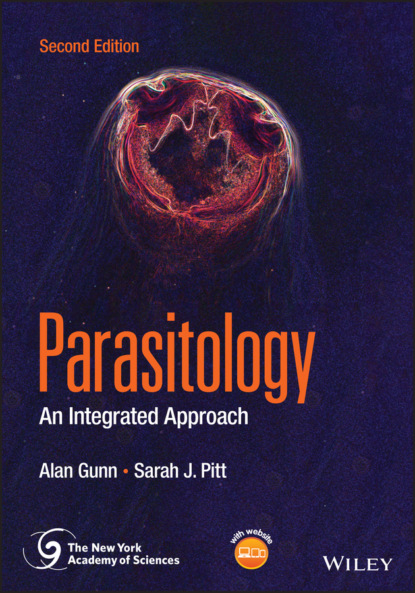3.3.2.6 Pentatrichomonas hominis
This parasite usually lives as a harmless commensal in our large intestine and caecum. It has a worldwide distribution and in addition to humans, it colonizes the large intestine of many wild and domestic mammals, including sheep, dogs, pigs, and monkeys. However, the extent to which zoonotic transfer occurs is uncertain.
The trophozoite is pear‐shaped, 5–15 μm long, and 7–10 μm wide with four free flagellae at the anterior end (Figure 3.7). A fifth flagellum curves back to form an undulating membrane that extends the length of the body and then projects freely from the posterior apex.
Prevalences tend to be higher in children than in adults. Sometimes it is associated with diarrhoea but whether it causes the condition is not known. Similarly, although there is a higher prevalence of P. hominis in patients suffering from gastrointestinal cancer than in healthy patients, whether there is a causative association is uncertain (Zhang et al. 2019).
3.4 Phylum Apicomplexa
The Apicomplexa is one of the largest phyla amongst the protozoa and includes many important parasites of humans and domestic animals (Table 3.1).
As with many other protozoa, the taxonomic arrangements within the Apicomplexa are in a state of flux. All members of the phylum are obligate intracellular parasites of invertebrates and vertebrates. A common feature shared by all apicomplexans is the presence within their invasive stage of a unique intracellular structure called the apical complex that is composed of a group of secretory organelles called the micronemes and rhoptries (Figure 3.9). The apical complex lies at the anterior apex of the cell where it is associated with a region called the oral structure. The secretions of the micronemes and the rhoptries play an important role in the invasion of red blood cells by the malaria parasites (Suarez et al. 2019).
Table 3.1 Representative examples of parasitic protozoa belonging to the phylum Apicomplexa to illustrate the wide variety of hosts and transmission strategies.
| Genus | Example | Host | Transmission | Disease |
|---|---|---|---|---|
| Plasmodium | Plasmodium falciparum | Humans | Vector: Anopheline mosquitoes | Malaria |
| Toxoplasma | Toxoplasma gondii | All warm‐blooded animals | Contamination, congenital, ingestion of infected flesh | Toxoplasmosis |
| Neospora | Neospora caninum | Dogs, cattle | Contamination, congenital | Neosporosis |
| Cyclospora | Cyclospora cyetanensis | Humans | Contamination | Cyclosporosis |
| Eimeria | Eimeria tenella | Poultry | Contamination | Coccidiosis |
| Theileria | Theileria parva | Cattle | Vector: Rhipicephalus ticks | East Coast Fever |
| Babesia | Babesia bigemina | Cattle | Vector: Rhipicephalus ticks | Texas Fever |
| Isospora | Isospora belli | Humans | None | Isosporosis |
| Cryptosporidium | Cryptosporidium hominis | Humans | Contamination | Cryptosporidiosis |
Figure 3.9 Generalized diagram of the invasive stage of an apicomplexan parasite. Abbreviations: Ac: apical complex (conoid + polar ring); Ap: apicoplast; Dg: dense granules; Mic: micronemes; Mit: mitochondrion; Mp: micropore; N: nucleus; Rho: rhoptries.
Plastids in Parasites
Apicomplexans contain a unique organelle called the apicoplast that probably evolved from a chloroplast (plastid) although it does not contain any pigments. Molecular studies indicate that the protozoa currently comprising the Apicomplexa arose from at least three independent transitions of free‐living photosynthetic algae to intracellular parasites (Mathur et al. 2019). The apicoplast has four membranes and contains DNA although most of the genes that code for proteins within it have transferred to the nucleus. Interestingly, a protist, Chromera velia, that is phylogenetically related to the Apicomplexans contains a functioning plastid that is morphologically similar to that found in the Apicomplexans (Moore et al. 2008). Chromera velia is usually free‐living, but it can form endosymbiotic relationships with the larvae of certain corals. It is related to the dinoflagellate algae – a group that includes species that combine photosynthesis with other forms of nutrition, including predation. The apicoplast is of interest because it has no equivalent in the parasite’s animal hosts and therefore is a potential target for specifically designed chemotherapeutics. The apicoplast produces essential metabolites and the parasites die if exposed to drugs that interfere with its functions (Lim et al. 2016).
Molecular phylogeny suggests that some of the Kinetoplastida may also have contained plastids at an early stage in their evolution, but these have since been lost. Many euglenid protozoa contain chloroplasts (e.g., Euglena gracilis), and these are closely related to the Kinetoplastida. However, ultrastructural studies suggest that the euglenids acquired their plastids after the point at which they diverged from the Trypomastigota (Leander 2004).
3.4.1 Genus Plasmodium
The genus Plasmodium probably evolved hundreds of millions of years ago and long before the arrival of the vertebrates (Escalante and Ayala
